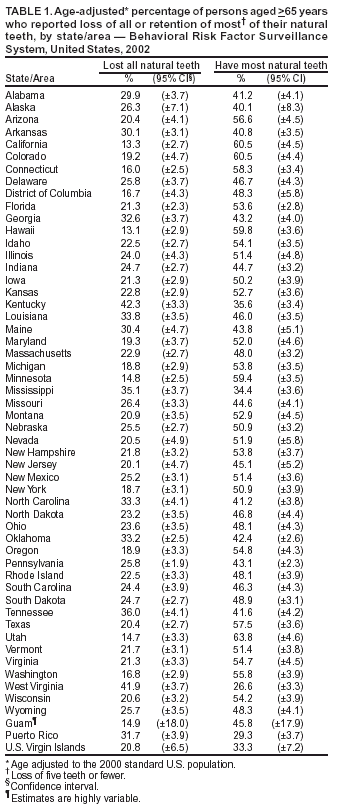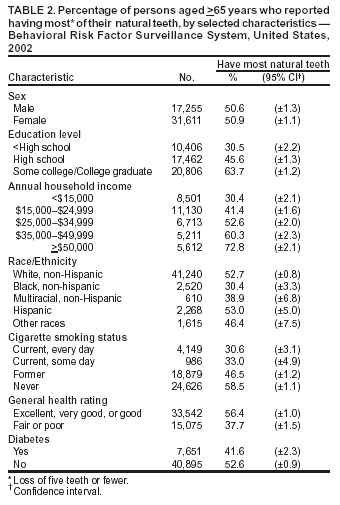 |
|
|
|
|
|
|
| ||||||||||
|
|
|
|
|
|
|
||||
| ||||||||||
|
|
|
|
|
Persons using assistive technology might not be able to fully access information in this file. For assistance, please send e-mail to: mmwrq@cdc.gov. Type 508 Accommodation and the title of the report in the subject line of e-mail. Public Health and Aging: Retention of Natural Teeth Among Older Adults --- United States, 2002During the past several decades, the percentage of older adults who have retained their natural teeth has increased steadily (1). This trend is expected to continue, resulting in improved oral function and quality of life (2). To estimate the prevalences of tooth retention and total tooth loss in 2002 among adults aged >65 years, CDC analyzed data from the Behavioral Risk Factor Surveillance System (BRFSS) survey. This report summarizes the results of that analysis, which indicated that in 26 (52%) states, more than half of older adults reported having most (i.e., losing five or fewer) of their natural teeth. However, rates varied substantially among states and by selected characteristics. With tooth retention, older adults remain at risk for dental caries (i.e., tooth decay) and periodontal disease. To help adults maintain healthy teeth for life, community-based strategies should promote healthy behaviors, optimal use of fluoride, timely examinations and clinical services, and increased research into preventing oral diseases and promoting oral health among adults (3,4). BRFSS is a state-based, random-digit--dialed telephone survey of the noninstitutionalized U.S. civilian population aged >18 years, administered in all 50 states, the District of Columbia, and three U.S. territories (Guam, Puerto Rico, and the U.S. Virgin Islands). In 2002, the median response rate was 58.6%. In 1999, oral health questions were added to the core interview of the survey to improve surveillance of oral health among older adults at the state level. In 2002, respondents were asked how many of their permanent teeth were removed because of tooth decay or gum disease. Of the 50,635 survey participants aged >65 years who were asked this question, 48,866 (96%) responded; nonresponders were excluded from this analysis. State-specific estimates were age-adjusted to the 2000 standard U.S. population. A complete adult dentition is made up of 28--32 permanent teeth; those persons who reported losing five or fewer teeth were considered to have most of their teeth. In 26 states, >50% of older adults reported having most of their teeth (Table 1). Estimates ranged from 27% in West Virginia to 64% in Utah. In three states (California, Colorado, and Utah), >60% had retained most of their teeth, and in five states and territories (Kentucky, Mississippi, West Virginia, Puerto Rico, and the U.S. Virgin Islands), <40% had done so. The prevalence of edentate persons (i.e., those who have lost all their natural teeth) ranged from 13% in Hawaii and California to 42% in Kentucky. In 12 states, <20% of persons, and in two states (Kentucky and West Virginia), >40% reported total tooth loss (Table 1). Retention of most of their teeth by older adults was less common among those with less than a high school education (31%) than among those with more education (46%--64%), among those with annual household incomes of <$15,000 (30%) than among those with higher incomes (41%--73%), among non-Hispanic blacks (30%) than among non-Hispanic whites (53%) or Hispanics (53%), among persons who smoked every day (31%) and some days (33%) than among persons who had quit smoking (47%) or who had never smoked (59%), among persons with diabetes (42%) than among those without diabetes (53%), and among persons reporting fair or poor general health status (38%) than among those with good to excellent general health status (56%) (Table 2). Reported by: BF Gooch, DMD, PI Eke, PhD, DM Malvitz, DrPH, Div of Oral Health, National Center for Chronic Disease Prevention and Health Promotion, CDC. Editorial Note:Compared with younger persons, the current cohort of older adults likely experienced higher rates of dental caries and tooth extraction as young adults and are more likely to have lost all their teeth (1,5). However, data from successive national surveys indicate that the percentage of older adults losing all their natural teeth has declined substantially since the 1950s, when the majority of persons aged >65 years were edentate (1). The current cohort of older adults has likely benefited from substantial improvements during the preceding 50 years that have resulted in greater tooth retention (5). These improvements include community water fluoridation and fluoride dentifrice (i.e., toothpaste), advancements in dental technologies and treatment modalities, changing patient and provider attitudes and treatment preferences, improved oral hygiene, and regular use of dental services (1,5). Throughout the life span, teeth remain at risk for the two most prevalent oral diseases (i.e., dental caries and periodontal disease). Older adults remain at risk for new and recurrent decay that is untreated in approximately 30% of dentate adults (6). They are at increased risk for root caries because of both increased gingival (i.e., gum) recession that exposes root surfaces and increased use of medications that produce xerostomia (i.e., dry mouth) (2). Approximately 50% of persons aged >75 years have root caries affecting at least one tooth (2). Approximately 25% of older adults have loss of tooth-supporting structures because of advanced periodontal disease (2). Without early prevention and control interventions, these progressive conditions can demand extensive treatment to curb infection and restore function. The wide variation in rates of tooth loss and retention among states and by selected characteristics suggests that many older adults have not benefited fully from improvements in the prevention and control of oral diseases. Differences in tooth retention by education, income, and race/ethnicity reflect disparities in unmet dental needs (e.g., untreated caries and advanced periodontal diseases) among persons with limited education and income and among non-Hispanic blacks (2). The findings in this report indicate that Hispanics and non-Hispanic whites reported similar rates of tooth retention; however, other surveys have indicated that Mexican-Americans had higher rates of untreated caries than non-Hispanic whites (2). These associations might reflect differences in health literacy and behaviors, attitudes toward oral health and dental care, and access to and use of dental services and types of treatment received (1,2,7). The lower prevalence of tooth retention among smokers might be related directly to the adverse effects of cigarette smoking (7), which accounts for approximately half of all cases of periodontal disease in the United States (8). Self-ratings of health have been associated with functional ability (9). These associations suggest that older persons who report poorer general health are at increased risk for limited dexterity, mobility, and tolerance of stress; such factors can compromise abilities to maintain oral hygiene, visit a dental office, or tolerate treatment. The results of this study suggest that many aging adults who are in poorer general health have retained most of their natural teeth. These persons likely will need caregiver assistance and innovative strategies to maintain daily self-care, obtain regular oral assessments, and receive primary and secondary prevention services. The findings in this report are subject to at least four limitations. First, the sample is drawn from the noninstitutionalized population and excludes persons residing elsewhere (e.g., nursing homes or long-term--care facilities). Second, persons without residential telephone service (e.g., persons with lower incomes or households using cellular phones) are excluded. Third, results are self-reported data and have not been validated; however, a strong agreement between self-reported and clinically assessed number of teeth has been documented (10). Finally, measures of oral health status are limited to tooth loss. In the United States, older adults usually pay for dental services themselves without the benefit of insurance (2). Medicare does not cover routine services, and Medicaid provides only limited coverage in certain states; the majority of elderly persons lose their dental insurance when they retire (2). Community water fluoridation remains the most effective and cost-effective method for caries prevention (3); current dental recommendations provide additional guidance on best practices in fluoride use, such as brushing teeth twice daily with fluoride toothpaste (3). Expansion of community-based programs could help increasing numbers of dentate older adults manage their oral health needs. Programs that have focused historically on younger populations might promote oral health in older adults by 1) increasing public and professional awareness of common oral conditions, risk factors, and healthy behaviors; 2) expanding partnerships, especially with organizations focused on aging issues; 3) monitoring oral health status of older adults; 4) ensuring access to clinical services; and 5) increasing support for prevention research and involvement of oral health professionals in tobacco-control activities (3,4,7). References
Table 1  Return to top. Table 2  Return to top.
Disclaimer All MMWR HTML versions of articles are electronic conversions from ASCII text into HTML. This conversion may have resulted in character translation or format errors in the HTML version. Users should not rely on this HTML document, but are referred to the electronic PDF version and/or the original MMWR paper copy for the official text, figures, and tables. An original paper copy of this issue can be obtained from the Superintendent of Documents, U.S. Government Printing Office (GPO), Washington, DC 20402-9371; telephone: (202) 512-1800. Contact GPO for current prices. **Questions or messages regarding errors in formatting should be addressed to mmwrq@cdc.gov.Page converted: 12/18/2003 |
|||||||||
This page last reviewed 12/18/2003
|